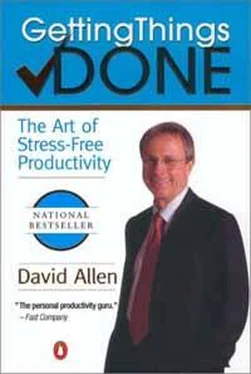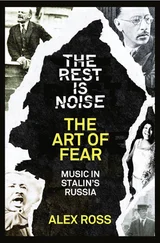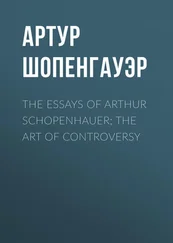As you develop your own customized system, what you eventually hand off and then track could look like a list in a planner, a file folder holding separate papers for each item, and/or a list categorized as "Waiting For" in your software. For now, if you don't have a trusted system set up already, just put a note on a piece of paper—"W/F: reply from Bob"—and put that into a "Pending" stack of notes in a separate pile or tray that may result from your processing.
What If the Ball Is Already in Someone Else's Court? In the example cited above about waiting for the last K-l to come in so you can do your taxes, the next action is currently on someone else's plate. In such situations you will also want to track the action as a delegated item, or as a "Waiting For." On the paper that says "Do my taxes," write something like "Waiting for K-l from Acme Trust" and put that into your "Pending" stack.
It's important that you record the date on everything you hand off to others. This, of all the categories in your personal system, is the most crucial one to keep tabs on. The few times you will actually want to refer to that information ("But I called and ordered that on March 12") will make it worth establishing this as a lifelong habit.
Defer It
It's likely that most of the next actions you determine for things in"in" will be yours to do and will take longer than two minutes to complete. A call you need to make to a customer; an e-mail you need to spend a little time thinking about and drafting to your team; a gift you need to buy for your brother at the stationery store; a piece of software you need to download from the Web and try out; a conversation you must have with your spouse about an investment you think you should make—all of these fit that description.
These actions will have to be written down somewhere and then organized in the appropriate categories so you can access them when you need to. For the moment, go ahead and put Post-its on the pieces of paper in "in," with the action written on them, and add these to the "Pending" stack of papers that have been processed.
The "Pending" Things That Are Left
If you follow the instructions in this chapter, you'll dump a mess of things, file a bunch, do a lot of two-minute actions, and hand off a number of items to other people. You'll also wind up with a stack of items that have actions associated with them that you still need to do—soon, someday, or on a specific date—and reminders of things you're waiting on from other people. This "Pending" group is made up of the actions you've delegated or deferred. It is what still needs to be organized in some fashion in your personal system, a topic I'll cover in step-by-step detail in the next chapter.
Identifying the Projects You Have
This last step in getting to the bottom of "in" requires a shift in perspective from the single-action details to the larger picture— your projects.
Again, I define a "project" as any outcome you're committed to achieving that will take more than one action step to complete. If you look through an inventory of actions that you have already been generating—"Call Frank about the car alarm"; "E-mail Bernadette re conference materials"—you'll no doubt recognize a number of things that are larger than the single action you've defined. There's still going to be something about "car alarm" to do after the call to Frank, and there will still be something to handle about the conference after the e-mail to Bernadette.
7. Organizing: Setting Up the Right Buckets
HAVING A total and seamless system of organization in place gives you tremendous power because it allows your mind to let go of lower-level thinking and graduate to intuitive focusing, undistracted by matters that haven't been dealt with appropriately. But your physical organization system must be better than your mental one in order for that to happen.
Airtight organization is required for your focus to remain on the broader horizon.
In this chapter I'll lead you through the organizing steps and tools that will be required as you process your in-basket. As you initially process "in," you'll create lists and groupings of things you want to organize and you'll invariably think of additional items to include. In other words, your organization system is not something that you'll necessarily create all at once, in a vacuum. It will evolve as you process your stuff and test out whether you have put everything in the best place for you.
I got it all together, but I forgot where I put it.
The outer ring of the Workflow Diagram (opposite) shows the main groupings into which things will go as you decide what they are and what needs to be done about them.
The Basic Categories
There are seven primary types of things that you'll want to keep track of and manage from an organizational perspective:
• A "Projects" list
• Project support material
• Calendared actions and information
• "Next Actions" lists
• A "Waiting For" list
• Reference material
• A "Someday/Maybe" list
The Importance of Hard Edges
It's critical that all of these categories be kept pristinely distinct from one another. They each represent a discrete type of agreement we make with ourselves, and if they lose their edges and begin to blend, much of the value of organizing will be lost.
The categories must be kept visually, physically, and psychologically separate.
If you put reference materials in the same pile as things you still want to read, for example, you'll go numb to the stack. If you put items on your "Next Actions" lists that really need to go on the calendar, because they have to occur on specific days, then you won't trust your calendar and you'll continually have to reassess your action lists. If you have a project that you're not going to be doing anything about for some time, it must go onto your "Someday/Maybe" list so you can relate to the "Projects" list with the rigorous action-generating focus it needs. And if something you're "Waiting For" is included on one of your action lists, you'll continually get bogged down by nonproductive rethinking.
All You Really Need Is Lists and Folders
Once you know what you need to keep track of (covered in the previous chapter, on Processing), all you really need is lists and folders for reference and support materials. Your lists (which, as I've indicated, could also be items in folders) will keep track of projects and someday/maybes, as well as the actions you'll need to take on your active open loops. Folders (digital or paper-based) will be required to hold your reference material and the support information for active projects.
I would not give a fig for the simplicity on this side of complexity, but I would give my life for the simplicity on the other side of complexity.
— Oliver Wendell Holmes
Lots of people have been making lists for years but have never found the procedure to be particularly effective. There's rampant skepticism about systems as simple as the one I'm recommending. But most list-makers haven't put the appropriate things on their lists, or have left them incomplete, which has kept the lists themselves from being very functional. Once you know what goes on the lists, however, things get much easier; then you just need a way to manage them. As I've said, you shouldn't bother to create some external structuring of the priorities on your lists that you'll then have to rearrange or rewrite as things change. Attempting to impose such scaffolding has been a big source of frustration in many people's organizing. You'll be prioritizing more intuitively as you see the whole list, against quite a number of shifting variables. The list is just a way for you to keep track of the total inventory of active things to which you have made a commitment, and to have that inventory available for review.
Читать дальше











